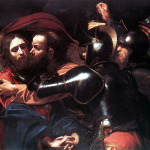Chapter and verse divisions are a modern introduction to our bible, coming from Archbishop of Canterbury Stephen Langdon in the middle ages. The text of the bible originally had no divisions – not even gaps between words! It looked something like this.
This is entirely foreign to modern readers. In the Literary Structure of the Old Testament, David A. Dorsey states
Graphical signals bombard the reader of a book in modern western culture. Italics or underlining highlight words and phrases or special importance, while parentheses, footnotes, and appendices remove peripheral material from the direct course of the writer’s argument. Chapter headings, section titles, and paragraph indentations divide the text into segments whose limits coincide with units of the writer’s thought. Tables of contents outline the entire book, and sometimes even chapters or articles within the book.
The absence of such visual structure markers does not mean that the ancient authors were unmindful of the structure of their compositions had less rigorous structural patterns than our modern books.
Since most of the audience would not be reading the text but hearing it read aloud, ancient authors relied upon oral rather than graphic means to structure their works.
In Star Wars, Parallel Structures and the Bible I noted the way authors used parallels to structure there work. In this post I want to look at another form of paralell structures known as inverted parallelism or chaism.
The symmetric (or chiastic or introverted) pattern is also relatively common in the Hebrew Bible. Symmetry generally features two sets of units, in which the units of the second set match in reverse order the units of the first set: a-b-c II c’=b’=a’. There is often an unmatched central unit linking the two matching sets: a-b-c-b’-a’ (sometimes called “uneven chiasmus”). An example of a simple chiasmus from English literature is Pope’s line: “a wit with dunces, and a dunce with wits.”
The symmetric pattern has several compelling advantages:
- Beauty: humans appreciate the esthetic quality of a balanced presentation, whether it be in art, music, architecture, or literature.
- Coherence: a symmetry’s tight configuration reinforces its unity.
- Sense of completeness: the audience can recognize when the composition is “winding down,” and they know it has concluded when it echoes its beginning. A symmetrically arranged piece “comes full circle,” ending where it began.
- Central pivot: in a more extensive symmetry with an uneven number of units (e.g., a-b-c-d-c’-b’-a’), the central unit is the natural location for the turning point, climax, high point, or centerpiece, since it marks the point where the composition reverses its order. Both halves of the symmetry look toward the center unit, making it the natural focal point.
- Memory aid: both speaker and audience can remember the successive points of a speech more easily with the aid of the symmetric organization.
- Opportunities to exploit the repetitions: as with the parallel pattern, repetitions provide opportunity to do such things as compare, contrast, reiterate, emphasize, explain and illustrate.















